



The Hologram is a viral distribution system for non-expert healthcare. Its protocol ensures that all caretakers are cared for, and regards properly supporting someone else’s wellbeing as therapeutic in itself.
This project was developed by a group of exhausted and anxious US artists, organizers and healers who experienced housing insecurity, inconsistent healthcare and massive debt, forced to scrounge and scam for care in between gigs.
The Hologram now lives on by different names with and through these people in venues all over the world. This workshop is aimed at anyone who is interested, and whose precariousness and fear of the (non-)future is the most reliable part of their life.
It is especially aimed at those whose waged or unwaged work is to transform the imagination (including artists, organizers, teachers, and activists). The wish is for all participants to connect to an “intentional community in exile” by learning to trust others in the same situation, and to rely on them for help navigating a world based on the capitalist sabotage of our health and thriving.
In a series of four free evening sessions, we will practice and discuss social skills, values, and priorities that are central to the Hologram model. These are powers that we may have forgotten or sold while fighting for our individual financial survival.
The course will involve a collective exploration of participants’ health as a common phenomenon. Each person will leave the course empowered to assemble and participate in their own Hologram and to network it with others.
Please note The Hologram talk and workshops are now taking place online due to pandemic restrictions. Contact info@furtherfield.org if you need any further information or assistance.
About the course co-facilitators
Cassie Thornton is an artist and activist who makes a “safe space” for the unknown, for disobedience and for unanticipated collectivity. She uses social practices including institutional critique, insurgent architecture, and “healing modalities” like hypnosis and yoga to find soft spots in the hard surfaces of capitalist life. Cassie has invented a grassroots alternative credit reporting service for the survivors of gentrification, has hypnotized hedge fund managers, has finger-painted with the grime found inside banks, has donated cursed paintings to profiteering bankers, and has taught feminist economics to yogis (and vice versa). She has worked in close collaboration with freelance curators and producers including Taraneh Fazeli, Magdalena Jadwiga Härtelova, Dani Admiss, Amanda Nudelman, Misha Rabinovich, Caitlin Foley, and Laurel Ptak. Her projects, invited and uninvited, have appeared at (or in collaboration with) Transmediale Festival for Media Arts, San Francisco MoMA, West Den Haag, Moneylab, Swissnex San Francisco, Pro Arts Gallery & Commons, Dream Farm Commons, Furtherfield, Gallery 400, Strike Debt Bay Area, Red Bull Detroit, Elizabeth Foundation for the Arts, Flux Factory, Bemis Center for the Arts, Berliner Gazette and more.
Lita Wallis is a youth worker, organiser, and informal educator based in London. Whether in work or her personal life, Lita has spent much of her time experimenting with different shapes of supportive relationships (eg. cooperatives, triangles, flows and webs.) She is still working on ways to build sustainable support networks that challenge isolating social norms, and then how to commit to them in a social context that is so hostile to putting down roots. Four years ago she and two friends made a lifelong commitment to The Tripod, a platonic support system, which aims to provide much of the financial, emotional and housing support that many people end up relying on couple relationships for. She hopes to bring some learning from this experience, plus some seeds of inspiration from her work with young people and her avid sci-fi habit, to set founding Hologram members fourth in good stead.
The Hologram is part of Furtherfield’s three-year Citizen Sci-Fi programme crowdsourcing creative and technological visions of our communities and public spaces, together.
2020 is the year of Love Machines, nurturing living and machine systems for mutual care and respect on earth and beyond.
An insurgency of sick artists is organising to resist the global crisis of care, from bed and over the phone. In these days of compulsive overwork in the so-called creative economy, we’re all sick artists. Using ancient technologies of peer-to-peer care, a grassroots health monitoring and diagnostic system is emerging, practiced from beds and couches all over the world. Participants co-produce a multi-dimensional image of each other’s physical, psychological, and social health. We call this image The Hologram. Through workshops in the spring and at Furtherfield Gallery or online in the autumn, visitors can learn about the Hologram and audition for a place in this viral sci-fi health system. Look out for couch-based performances throughout Finsbury Park.
The Hologram is part of Furtherfield’s three-year Citizen Sci-Fi programme crowdsourcing creative and technological visions of our communities and public spaces, together.
2020 is the year of Love Machines, nurturing living and machine systems for mutual care and respect on earth and beyond.
Love Machines Exhibition: 15 May – 21 Oct, Sat – Sun, 11:00 – 17:00, or by apt, Furtherfield Gallery, Website, and Social Media
Please note The Hologram talk and workshops are now taking place online as a response to pandemic restrictions. Contact info@furtherfield.org if you need any further information or assistance.
Cassie Thornton is an artist and activist who makes a “safe space” for the unknown, for disobedience and for unanticipated collectivity. She uses social practices including institutional critique, insurgent architecture, and “healing modalities” like hypnosis and yoga to find soft spots in the hard surfaces of capitalist life. Cassie has invented a grassroots alternative credit reporting service for the survivors of gentrification, has hypnotized hedge fund managers, has finger-painted with the grime found inside banks, has donated cursed paintings to profiteering bankers, and has taught feminist economics to yogis (and vice versa). She has worked in close collaboration with freelance curators and producers including Taraneh Fazeli, Magdalena Jadwiga Härtelova, Dani Admiss, Amanda Nudelman, Misha Rabinovich, Caitlin Foley, and Laurel Ptak. Her projects, invited and uninvited, have appeared at (or in collaboration with) Transmediale Festival for Media Arts, San Francisco MoMA, West Den Haag, Moneylab, Swissnex San Francisco, Pro Arts Gallery & Commons, Dream Farm Commons, Furtherfield, Gallery 400, Strike Debt Bay Area, Red Bull Detroit, Elizabeth Foundation for the Arts, Flux Factory, Bemis Center for the Arts, Berliner Gazette and more.
Artist Cassie Thornton, of the Feminist Economics Department (the FED), will discuss The Hologram, a mythoreal collective peer-to-peer health project currently incubating at Furtherfield Gallery in London.
The Hologram, based on the understanding that all our crises are connected and everyone is a little sick, is a viral four-person health monitoring and diagnostic system practiced from couches all over the world.
Three non-expert participants create a three-dimensional “hologram” of a fourth participant’s physical, psychological and social health, and each becomes, in turn, the focus of three other people’s care in an expanding network.
This health distribution system is based on the experimental care models developed in the Social Solidarity Clinics in Greece during the height of the financial and migration crisis. The result is the construction of a robust network of multi-dimensional health, collectively oriented social practices, and trust that can outlive racial capitalism.
The presentation will be followed by a discussion of themes and topics. We welcome artists, healers, activists and system builders with an interest in alternative infrastructures and care as an act of resistance.
Please note The Hologram talk and workshops are now taking place online due to pandemic restrictions. Contact info@furtherfield.org if you need any further information or assistance.
About the artist
Cassie Thornton is an artist and activist who makes a “safe space” for the unknown, for disobedience and for unanticipated collectivity. She uses social practices including institutional critique, insurgent architecture, and “healing modalities” like hypnosis and yoga to find soft spots in the hard surfaces of capitalist life. Cassie has invented a grassroots alternative credit reporting service for the survivors of gentrification, has hypnotized hedge fund managers, has finger-painted with the grime found inside banks, has donated cursed paintings to profiteering bankers, and has taught feminist economics to yogis (and vice versa). She has worked in close collaboration with freelance curators and producers including Taraneh Fazeli, Magdalena Jadwiga Härtelova, Dani Admiss, Amanda Nudelman, Misha Rabinovich, Caitlin Foley and Laurel Ptak. Her projects, invited and uninvited, have appeared at (or in collaboration with) Transmediale Festival for Media Arts, San Francisco MoMA, West Den Haag, Moneylab, Swissnex San Francisco, Pro Arts Gallery & Commons, Dream Farm Commons, Furtherfield, Gallery 400, Strike Debt Bay Area, Red Bull Detroit, Elizabeth Foundation for the Arts, Flux Factory, Bemis Center for the Arts, Berliner Gazette and more.
The Hologram is part of Furtherfield’s three-year Citizen Sci-Fi programme crowdsourcing creative and technological visions of our communities and public spaces, together.
2020 is the year of Love Machines, nurturing living and machine systems for mutual care and respect on earth and beyond.
DIWO (Do-It-With-Others): Origin, Art & Social Context, is an update on Furtherfield’s artistic and cultural practice of DIWO. In light of the emergence of DIWO in other fields of creative practices, and its ever growing popularity. We reconnect to the original reasons of why Furtherfield introduced and shared the concept of DIWO to the world in the first place.
We revisit early historical influences from 60s and 70s Mail Art, Fluxus, Situationism, Activism and D.I.Y culture; early adventures/projects with pirate radio, a mass networked email art, and (snail mail) mail art’, street art project by Furtherfield back in 1999; to what DIWO is now today, part of a more extensive, and networked grass roots movement around the world.
It also draws upon links to P2P (peer to peer) culture, the free and open source movement. Each of these cultural activities are seen as equal, peer relations, and re-hacks an intuitive space away from traditional hegemonies and their established hierarchies.
It re-emphasize it’s core motives, as a critique against mainstream media and the traditional art establishment’s control over our art history and contemporary art imaginations. It challenges the non-critical nature of artists’ complicit desire in conforming to celebrity status and fitting into stereotypical behaviours informed by hegemony, and cultural dominance. Furthefield’s intention for DIWO has always been a about individual and collective emancipation, and this story is about what this means now…
Before we jump into Furtherfield’s first DIWO project it’s worth mentioning an earlier historical reference to Bristol city (UK) and pirate radio. I, and a dedicated group of individuals were interested in finding alternative avenues for community and collective expression. We set up various pirate radio stations in Bristol, the longest running was ‘Electro Magnetic Installation (EMI)’ pirate radio station, which ran for over 18 months, broadcasting to greater Bristol every weekend ending in 1991. We changed our location for each broadcast and disseminated disinformation to confuse the authorities. We used a home built 20 Watt stereo FM transmitter and antenna. All submitted material was provided on audio tape for broadcast, the quality or quantity was not edited and everyone interested had their sound art, cut up mixes, music and words heard by many. We had to close down after a while due to surveillance stress. We did re-emerge with other pirate radio broadcasts briefly, under various different names. An even earlier one, which we took over for a while was called ‘savage but tender’ in 1989.
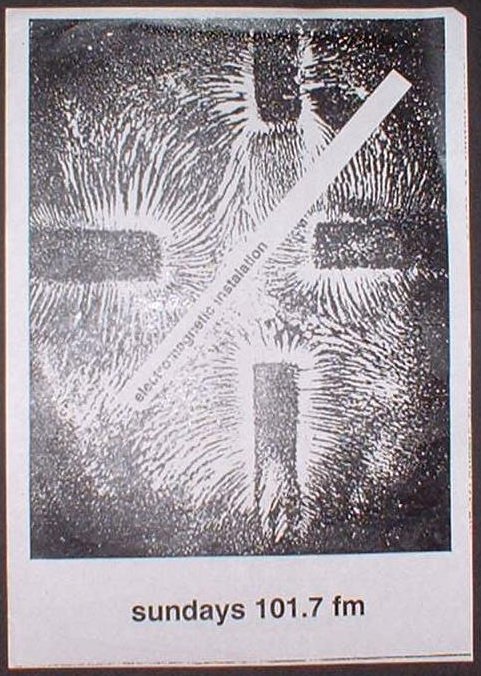
Bristol in the late 80s and early 90s was a dynamic and exciting place to be. Especially if one was creative and also interested in alternative ways of thinking and living. Independent culture was thriving. It was back in the 70s when Bristol’s radical spirit of creative and political autonomy was first forged. Post punk bands such as the Pop Group, Rip Rig & Panic, spread their own influential ethos of being creative and activist as a way of life. Advocating everyday people could be different, be independent thinkers and question the validity of the established norm. This flexible blueprint of being socially conscious in an imaginative way influenced a huge mixture of genres for years to come. Breaking down the borders between the audience and the musicians playing was a legacy handed on down from punk. This includes building your own record label, setting up your own pirate radio station, self publishing and other ventures.
Furtherfield’s first collective (yet unofficial) DIWO experience was at the Watermans Art Centre, London in 1999. We were asked to present a project which reflected the free and liberated spirit of our networked on-line community and its creative culture. The name of the project was called “Pasteups@Watermans Art Centre”, not DIWO. It had all the features of DIWO, such as using email as art, and the traditional postal services (snail mail) as part of its distribtion process. From all over the world people were invited to send images and texts which were then enlarged into a mass of photocopied posters.

On Sunday 10th October 1999 all the hoardings and wall spaces in the streets around the Watermans Art Centre were blitzed with Pasteups. There was no selection of what should be taken out or left in, everything was shown. They were put up by the Furtherfield crew and who ever wished to help out. Some of those whom took part were also local to the area. The people working in the centre reacted as if they were being over taken from a dark external force, and the passing public were expressing a mixture of emotions – enjoyment, surprise, interest, confusion, distaste and annoyance. It challenged the ideal of art having to be a rigid divide and rule of amateur vs professional, using the Internet and the physicalness of the Watermans Art Centre’s building, inside and outside. The streets were used as a shared canvas to fill our collective, imaginative expressions at that time.
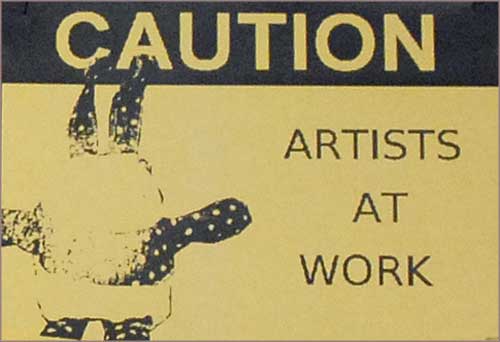
“”… the role of the artist today has to be to push back at existing infrastructures, claim agency and share the tools with others to reclaim, shape and hack these contexts in which culture is created.” [1] (Catlow 2010)
In her study ‘Empire of Dirt: The Aesthetics and Rituals of British Indie Music (Music Culture)’, Dr. Wendy Fonarow [2] investigated the UK’s indie music scene and its culture from the early 1990s to present. Below Fonarow presents the differences between mainstream and independent music culture. Contrasts are mapped out in Lévi-Straussian fashion:
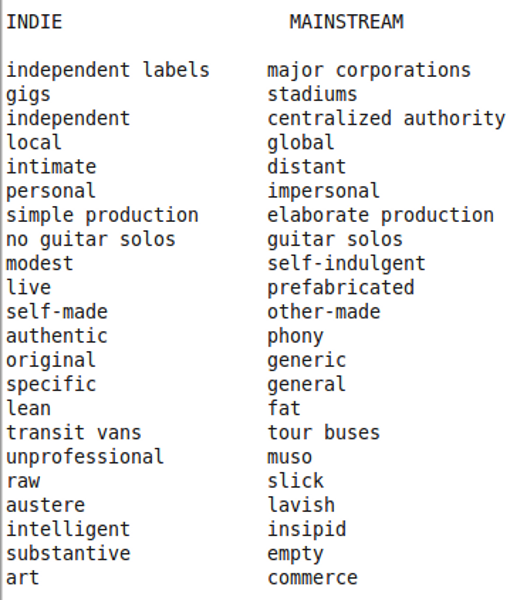
“Indie itself in relation to the mainstream as an opositional force combating the dominant hegemony of modern urban life. Any band that is seen as “chipping away at the facade of of corporate pop homogeny” (Melody Maker, April 1995) is a positive addition to the indie fellowship.”[3] (Fonarow 2006)
There are similar terms above as there is with critical practices in Media Art culture, Free and Open Source culture, activism and hacktivism, and with concepts behind DIWO. Words such as self-made, independent, raw and substantive offer strong relational ties to what we feel ourselves is essential for a thriving, discerning and critically aware process, of an unfettered state of discovering, and how to do things without conforming to top-down protocols, individually or collaboratively.
“To be an artist is to contend with the present, and there are not many other careers that afford the freedom to radically examine life and society. To put it bluntly, if artists are studying and writing more about politics, culture, and education, it’s probably a reflection of the unprecedented dysfunctionality of the societies in which they live.” [4] (Deck 2005)
When considering an art context, critical thinking on the social nuances, social and relational variants introduce possibilities for a deeper understanding of the meaning of a work and its place in the wolrd. Not only in respect of the quality of an artwork in its own right, but it also introduces consideration concerning value. Value comes out of dialogue whilst the work is put into motion, as the process occurs as well as when it reaches its final stage of being seen – it’s birth is always messy, but this process gives us the rich nutriants, the substance.
By recognising resonances that lurk between art and culture and our own connections with these elements; as we make things with others different core values come into play. This is where knowledge of how an artwork and its meaning communicates beyond the artwork itself; to and with others, linking up to the ever changing rhythms dominating society. All this, also depends on the context of how and where a work is seen. An artwork and where it is seen declares the artists’ relationship with other structures, infrastructures and networks, whether this be physical or based on-line. This informs us about the artists’ personal concepts, attitudes and social values. These attributes become part of the work; its story and part of its essence and its reasons for existing in the first place.
Whoever controls our art – controls our connection, relationship and imaginative experience and discourse around it. The frameworks and conditions where art is accessed, seen and discussed is significantly linked to representation and ownership. Socially and culturally, this process of abiding by specific rules and protocols defines who and what is worth consideration and acceptance. For art to be accepted within these ‘traditional’ frameworks a dialogue reflecting its status around a particular type of function kicks into place, it must adhere to certain requirements. Whether it is technological or using traditional art making skills the art itself must in some way conform to specific protocols before it can be allowed into the outer regions of ‘officially’ condoned culture. This process adds merit to the creative venture itself and feeds a systemic demand based around innovation in a competitive marketplace. If an iindividual or an collective does not abide by these dominating rules then they will not be seen in these frameworks. DIWO allows one to venture with many, in playful scenarios of mutual experience and interdependence, freeing up the trappings of ‘officially’ defined protocols and frameworks, governing our behaviours. This does not mean that there are no rules, it merely means that we have a more relationally informed understanding of how to work with others. Structures and aims are decided in different terms mutually.
DIWO is playful re-interpretation and fruition of some of the principles and reasons that Furtherfield was originally founded, back in 96-97. We had experienced as artists in the 80s and well into the 90s, a UK art culture mainly dominated by the marketing strategies of Saatchi and Saatchi. The same company was responsible for the successful promotion of the Conservative Party (and conservative culture) that had led to the election win of the Thatcher government in 1979. We felt that it was time to make a stance against these neoliberalist heavies controlling the art scene and our every day culture. Our aim was to move away from the typically established, sociallly engineered aspects of art culture where false credence was given to a few individuals over many others, based on their personalities alongside their depoliticized artworks.
“Furtherfield’s roots extend back through the resurgence of the national art market in the 1980s, to the angry reactions against Thatcher and Major’s Britain, to the incandescence of France in May 1968, and back again to earlier intercontinental dialogues connecting artists, musicians, writers, and audiences co-creating “intermedial” experiences.” [5] (Da Rimini 2010)
Our move away from this was to create pro-active alternatives, with social hacks, bypassing the marketing myth of the ‘genius’ as a product via the usually distracting diversions, and top-down imposed spectacles based on privilege and hegemony. Recently an article written by John A. Walker on the artdesigncafé web site, disucussed how art culture is still haunted by the power of Charles Saatchi.
“Arguably, as an art collector Charles Saatchi has become a brand in his own right—when he buys art works they and the artists who created them are immediately branded.” [6] (Walker 2010)
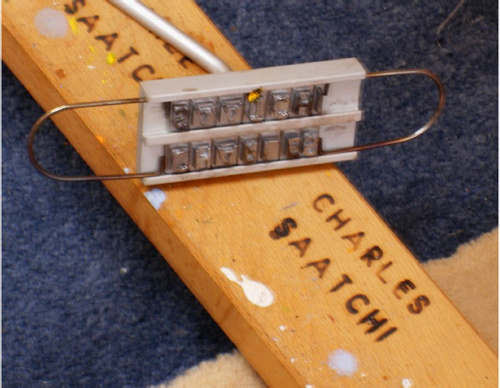
BritArt’s dominance of the late 80s and 90s UK art world dis-empowered the majority of British artists, and Smothered other artistic discourse by fuelling a competitive and divisive attitude for a shrinking public platform for the representation of their own work. Stewart Home proposes that the YBA movement’s evolving presence in art culture fits within the discourse of totalitarian art.
“The cult of the personality is, of course, a central element in all totalitarian art. While both fascism and democracy are variants on the capitalist mode of economic organisation, the former adopts the political orator as its exalted embodiment of the ‘great man,’ while the latter opts for the artist. This distinction is crucial if one is to understand how the yBa is situated within the evolving discourse of totalitarian art.” [7] (Home 1996)
By questioning the myths that dominate our actions we then become more empowered and confident to collaborate with others. We can only rediscover these inner creative kernals by critiquing the infrastructures dominating our behaviours. Many artists have and do conform to mainstream art world rules. This closes down space for a wider dialogue and experience for art practice to expand its possible horizons, beyond a handed down, hermetically sealed set of distant processes. When experimenting with alternative approaches of imaginative engagement a different set of values arrive. Through this we unearth things about ourselves which were already there but were trapped before by the mechanisms and mannerisms of mainstream culture and its dominant values.
DIWO (Do It With Others) is inspired by DIY culture and cultural (or social) hacking. Extending the DIY ethos with a fluid mix of early net art, Fluxus antics, Situationism and tactical media manoeuvres (motivated by curiosity, activism and precision) towards a more collaborative approach. Peers connect, communicate and collaborate, creating controversies, structures and a shared grass roots culture, through both digital online networks and physical environments. Stringly influenced by Mail Art projects of the 60s, 70s and 80s demonstrated by Fluxus artists’ with a common disregard for the distinctions of ‘high’ and ‘low’ art and a disdain for what they saw as the elitist gate-keeping of the ‘high’ art world.
The term DIWO OR D.I.W.O, “Do It With Others” was first used on Furtherfield’s collaborative project ‘Rosalind’ (http://www.furtherfield.org/get-involved/lexicon). An upstart new media art lexicon, born in 2004. DIWO was officially termed here in 2006 (http://www.furtherfield.org/lexicon/diwo)
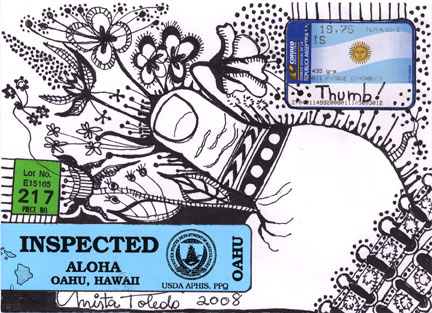
“It is in the use of the postal system, of artists’ stamps and of the rubber stamp that Nouveaux Realisme made the first gestures toward correspondence art and toward mail art.” [8] (Friedman 1995)
Mail Art is a useful way to bypass curatorial restrictions for an imaginative exchange on your own terms. With DIWO projects we’ve used both email and snail mail. Later, we will return to the subject of email art and how it has been used for collective distribution and collaborative art acitivies; but also, how it can act as a remixing tool and an art piece in its own right on-line and in a physical, exhibiting environment.
“[…] many Fluxus works were designed specifically for use in the post and so the true birth of correspondence art can arguably be attributed to Fluxus artists.” [9] (Blah Mail Art Library)
Many consider George Maciunas was to Fluxus, what Guy Debord was to Situationism. Maciunas set up the first Fluxus Festival in Weisbaden in Germany, 1962. In 1963, he wrote the Fluxus Manifesto in 1963 as a fight against traditional and Establishment art movements. In a conversation with Yoko Ono in 1961, they discussed the term and meaning of Fluxus. Showing Ono the word from a large dictionary he pointed to ‘flushing’.
“”Like toilet flushing!”, he said laughing, thinking it was a good name for the movement. “This is the name”, he said. I just shrugged my shoulders in my mind.” [10] (Ono 2008)
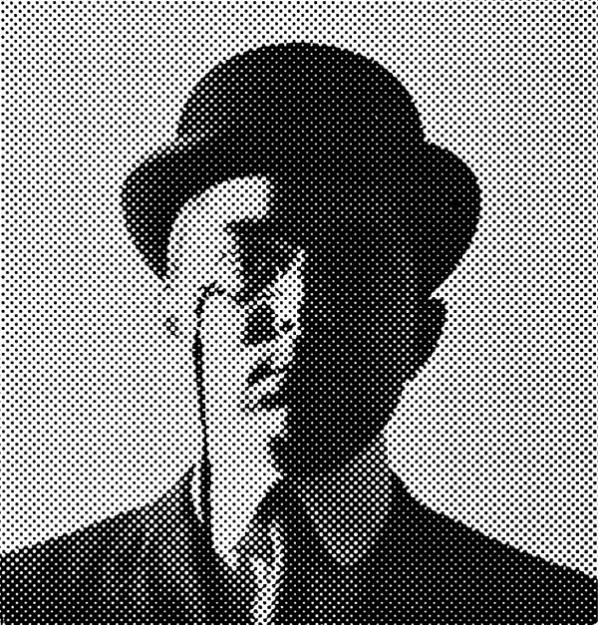
“The purpose of mail art, an activity shared by many artists throughout the world, is to establish an aesthetical communication between artists and common people in every corner of the globe, to divulge their work outside the structures of the art market and outside the traditional venues and institutions: a free communication in which words and signs, texts and colours act like instruments for a direct and immediate interaction.” [11] (Parmesani 1977)
Maciunas’s intentions and ideas are strongly based on creative autonomy. DIWO in the 21st Century explores its own position of (social) grounded reasoning and creative chaos. In contrast to the usual, standardized and bureaucratic implimentations by an increasingly banal, neoliberal elite controlling our art, education, media and economies.
“[…] art has become too narcissistic and self-referential and divorced from social life. I see a new form of participatory art emerging, in which artists engage with communities and their concerns, and explore issues with their added aesthetic concerns” [12] (Bauwens 2010)
“Marshall McLuhan once suggested that ‘art was a distant early warning system that can always tell the old culture what is beginning to happen to it'” [13] (Gere 2002) The infrastructural tendencies that occur when ‘the many’ practice DIWO; informs us we are in a constant process which redefines the role of the individual, and our notions of centralized power and behaviour. This process also presents us with critical questions around the value of art as scarcity. In moving away from our emotional attachment with the socially engineered dependencies based on consumer led forms of scarcity and desire, we then change the defaults. If we change the defaults we change the rules, no longer besieged by top-down defaults and open to more intuitive and relational contexts.
DIWO proposes in its fluid and sensual action of immediacy; situations where anyone can play and initiate collaborative and autonomous art. It is a radical creativity, asking questions through process and peer engagement, loosening infrastructural ties and frameworks as it occurs.
DIWO is a contemporary way of collaborating and exploiting the advantages of living in the Internet age. By drawing on past experiences with pirate radio, historical inspirations from Punk, with its productive move towards independent and grass roots music culture, as well as learning from Fluxus and the Situationists, and peer 2 peer methodologies; we transform our selves into being closer to a more inclusive commons. We transform our relationship with art and with others into a situation of shared legacy and emancipation.

“The network is designed to withstand almost any degree of destruction to individual components without loss of end-to-end communications. Since each computer could be connected to one or more other computers, Baran assumed that any link of the network could fail at any time, and the network therefore had no central control or administration (see the lower scheme).” [14] (Dalakov 2011)
Even though the web and DIWO possess different qualities they are both forms of commons. They both belong to the same digital complexity, and involve us connecting with each other. They are both open systems for human and technological engagement. DIWO rests naturally within these frameworks much like other digital art works or platforms and related behaviours, but possess key differences. If we consider the functions and structures of Facebook, Google, MySpace, itunes and now Delicious, they are all centralized meta-platforms, appropriating as much users as possible to repeatedly return to the same place.
“We see social media further accelerating the McLifestyle, while at the same time presenting itself as a channel to relieve the tension piling up in our comfort prisons.” [15] (Lovink 2012)
These meta-platfroms are closed systems. Not, necessarily closed as in meaning ‘you cannot come in’, but closed to others if you consider their motives and ‘acted out’ values, exploiting human interaction and their uploaded material, and openly ‘given’ data-information. These centralized meta-platforms close choices down through rules of ownership of personal data, as well as introducing more traditional standards of hierarchy, and limits one’s view and potential experience of the Internet.
Richard Barbrook and Andy Cameron saw this curious dichotomy way back in 1995. On one hand we had the dynamic energy of sixties libertarian idealism and then on the other, a powerful hyper-capitalist drive, Barbrook and Cameron termed this contradiction as ‘The Californian Ideology’. “Across the world, the Californian Ideology has been embraced as an optimistic and emancipatory form of technological determinism. Yet, this utopian fantasy of the West Coast depends upon its blindness towards – and dependence on – the social and racial polarisation of the society from which it was born. Despite its radical rhetoric, the Californian Ideology is ultimately pessimistic about real social change.” [16] (Barbrook and Cameron 1995)
Instead of submitting to an imperious process of allowing bland interaction own our behaviours; we propose an engagement where we can be more conscious and in control by exploiting further the real potential of the networks before us.
“We are not going to demand anything. We are not going to ask for anything. We are going to take. We are going to occupy.”[17] (RTS 1997)
Just like Reclaim the Streets which was an anti-car direct action movement seizing roads to prevent cars from being able to access them. Filling up public areas with thousands of bikes and using street parties as part of the political protest. We can loosen the gaze and spectacle of these propriety, meta-platforms and their dominance of our actions with others on the Internet. DIWO, is a way of thinking and acting differently, not an absolutist ‘technologically determined’ factor, but a thing of many things, and leans more towards a kind of social activism going as far back as The Diggers:
“The Diggers [or ‘True Levellers’] were led by William Everard who had served in the New Model Army. As the name implies, the diggers aimed to use the earth to reclaim the freedom that they felt had been lost partly through the Norman Conquest; by seizing the land and owning it ‘in common’ they would challenge what they considered to be the slavery of property. They were opposed to the use of force and believed that they could create a classless society simply through seizing land and holding it in the ‘common good’.” [18] (Fox)
Three elements pull DIWO together as a functioning whole, which can mutute according to a theme, situation or project. These three contemporary forms of (potential) commons mainly include; the ecological – the social – and the networks we use. By appropriating these three ‘possible’ processes of being with others; combined, they introduce and enhance potential for an autonomous and artistic process to thrive, further than the limitations of any single or centralized point of presence. It brings about small societal change, as long as we are conscious of the social nuances needed for a genuine and critically engaged, mutual collaboration.
“Online creation communities could be seen as a sign of reinforcement of the role of civil society and make the space of the public debate more participative. In this regard, the Internet has been seen as a medium capable of fostering new public spheres since it disseminates alternative information and creates alternativ (semi) public spaces for discussion.” [19] (Morell 2009)
In accordance with Mail Art tradition, DIWO began with an open-call to the Netbehaviour email list on 1st February 2007. The exhibition was at our older venue the HTTP Gallery, opening at the beginning of March. Every post to the list until 1st April was considered an artwork – or part of a larger collective artwork for the DIWO project. Participants worked across time zones, geographical and cultural distances with digital images, audio, text, code and software; they worked to create streams of art-data, art-surveillance, instructions and proposals, and in relay to produce threads and mash-ups.
One example of a work which exploited the data-steams of continual flow while over a hundred individuals participated and collaborated in DIWO in 2007, was X-ARN.org (Gregoire Cliquet, Laurent Neyssensas and Yann le Guennec). By using the dynamic exchange of the Netbehaviour email list as reliable exchange of regualr content, the net art group were able to perform their particular and unique processes of interaction, or intervention. It had no specific title, it was literally documenting the list’s networkked behaviour, and there were many of these networked visualizations made. They experimented with the net-specific aspects of DIWO’s mass artistic activity, forming digital mappings of this collected data or data-streams in ‘real-time’, as it all happened.

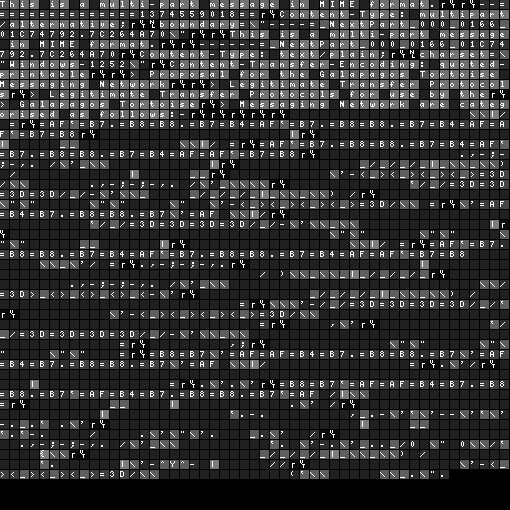
![[ARN / DIWO-Betatests 2007]](http://www.furtherfield.org/wp-content/uploads/2012/05/attachment3.png)
Some also participated in the experimental networked curation of the exhibition, facilitated by web cams, public IRC and VOIP technology. This co-curation event, or Curate With Others (CWO), as it was retroactively named, took place a week before the gallery opening. All subscribers to the NetBehaviour list were invited to contribute to the curation of the exhibition either by viewing the gallery floor plan and posting suggestions to the list or by taking part in the event; attending the gallery or joining the online meeting. Information about how to join the online event was posted to the list. During this event the spirit and philosophy of DIWO E-mail-Art were discussed, the deluge of diverse contributions by about a 100 people were reviewed, plinths, monitors and a drawing machine.
“The ‘Will Work For Food’ happening deals with the desire to find a new definition for labour and the act of working.” [20] (Jeron 2007)
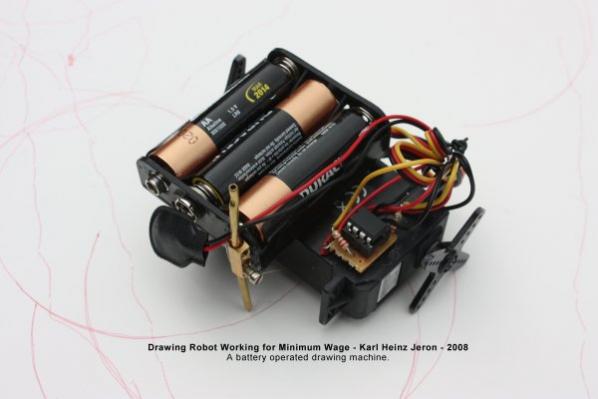
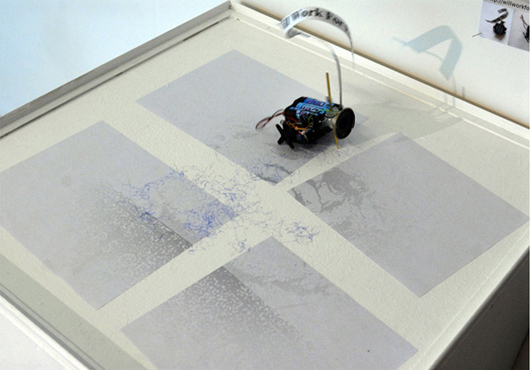
Karl Heinz Jeron’s drawing machine was a vehicle equipped with a ballpen run by rechargable batteries, and when turned on created random drawings. Jeron’s machine was not switched on, unless he received gifts in the post such as chocolates or any other form of economic support. After (thankfully) receiving various contributions in the post the image supplied by Jeron of Karl Marx would gradually be scribbled over.
This section of the Article is an edited version of a collaborative text by Ruth Catlow & Marc Garrett. Originally published on Vague Terrain in 2008. [21]
Present in the flesh were the Furtherfield.org crew and James Morris (regular, esteemed DIWO contributor).
Frederik Lesage manned the Public IRC and, as ‘DIWOchatbod’, who documented the conversation in the gallery for the benefit of those online co-curators who had trouble logging into Skype. Through the afternoon the online event was visited by eight people. The CWO event determined the format of the DIWO exhibition and the Furtherfield.org crew was charged with installing it. So, about approxximately 15 individuals on the day co-curated the setting up of the exhibition. Afterwards we informed everyone on the Netbeahviour list for any last minute details and suggestions and then continued with everything.
(Floorplan of Do It With Others (DIWO) at HTTP-Gallery, London. 2007)
The centerpiece of the exhibition was an e-mailbox containing all submissions; sorted and categorised for visitors to explore and redistribute by clicking ‘Forward Mail’. Streams and Themes displayed images, texts, sounds, code, and movies, primarily by single contributors (human and machine) as well as collections of themed posts or particular kinds of activity). Threads contained series of dialogic emails whose senders were remixing images, movies and code, most often in action and response). Other categories included Proposals and Instructions and Approaches to E-Mail Art.
(DIWO curated emailbox displaying image 3 tampered, posted by Chris Fraser 28/02/07)
Many of the themed folders and subfolders had their corollaries in the physical space of the gallery in the form of wiggly overlapping streams of printed images, pinned to the walls. Threads were represented by scrolls; one post after another in chronological order. A TV ran a video compilation, a sound compilation was played over four speakers, and two installation works were devised especially for the space. Karl Heinz Jeron’s ‘Will Work for Food’ and a print/projection mashup by Thomson and Craighead and Michael Szpakowski.
(Visitor to DIWO E-Mail Art at HTTP Gallery explores the DIWO email box. 2007. Image by Pau Ross)
All categories were liberally interspersed with off-topic discussion, tangents and conversational splurges so one challenge for co-curators was to reveal the currents of meaning, and emerging themes within the torrents of different kinds of data, process and behaviour. Another challenge was find a way to convey the insider’s – that is the sender’s and the recipient’s- experience of the work. These works then were made with a collective recipient in mind; subscribers to the Netbehaviour mailing list. This is a diverse group of people, artists, musicians, poets, thinkers, programmers (ranging from new-comers to old-hands) with varying familiarity with and interest in different aspects of netiquette and the rules of exchange and collaboration. This is reflected in the range of approaches, interactions and content produced. Before DIWO, extensive press releases were posted to different email lists, and online art platforms to join the Netbehaviour list to collaborate on the project.
(Lem Pollocked. By Lem Urtastik 16/2/07 / Created using Jackson Pollock artware by Miletos Manetas)
As with our previous experience of collective media arts ventures such as the first round of NODE.London Season of Media Arts (2006) [21] “we saw that lots of people invested with most enthusiasm in unstructured discourse; meandering and complex. This gave all participants a partial but meaningful view of the diverse contexts in which we worked, allowing us to make decisions about what our contribution could be. These many-to-many deep processes are never efficient but still invaluable to us in a culture where the pressures are always to be newer, faster, better-oiled, less philosophical, less human (ie less messy and complicated), more productive in the service of strategic overview.” (Garrett and Catlow) [ibid]
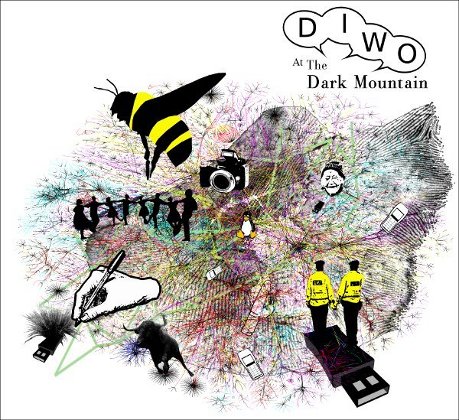
The next DIWO took place in 2009. It was called ‘Do It With Others (DIWO) at the Dark Mountain’. It was a collaboration between the then, newly formed ‘The Dark Mountain Project’, [22] Furtherfield and those participating in DIWO. A Dark Mountain manifesto grew out of a conversation between Paul Kingsnorth and Douglad Hine. It was an invitation to a new cultural response to the converging crises of climate change, resource scarcity and economic instability.
Paul Kingsnorth, in a letter to George Monbiot in the Guardian Newspaper which was also (openly) published by Monbiot said “As for saving the planet – what are we really trying to save, as we scrabble around planting turbines on mountains and shouting at ministers, is not the planet but our attachment to the western material culture, which we cannot imagine living without.” [23] The Dark Mountain Project wrote their Manifesto ‘UNCIVILISATION: the dark mountain manifesto’ “Old gods are rearing their heads, and old answers: revolution, war, ethnic strife. Politics as we have known it totters, like the machine it was built to sustain. In its place could easily arise something more elemental, with a dark heart.” [24] (DMP 2009)
The Dark Mountain Project has been viewed by many as apocalyptic, yet it also has grown in popularity these last few years. When discussing the project Hine says “Rather than treating these as distinct problems in need of technical solutions, we argued that they should be treated as symptoms of a deeper social and cultural crisis, a failure of the stories we have been telling ourselves for generations.” The Dark Mountain Project text was “addressed to other writers, and there is still a vein of Dark Mountain which is about finding new ways of writing, adequate to the times we are living through.” [25] (Hine 2009)
Kingsnorth and Hine both come from a literary background. Asking people to get involved in the project was a big ask.
DIWO E-Mail Art contributors in 2007 included: //indira, [–lo_y-], aabrahams, Alan Sondheim, Alexandra Reill, Allan Revich, Ana Valdes, Andre SC, Andrej Tisma, Ant Scott, arc.xolotl ARN, Aurlea, biodollsmouse, Bjorn Eriksson, Bjorn Magnhildoen, Blackmail, bob catchpole, bobig, brian@netart.org.uy, Camille Baker, Chris Fraser, Christphe Bruno, Clive McCarthy, cont3xt.net, Corrado Morgana, Daniel C. Boyer, dave miller, Denisa Kera, Dion Laurent, Eric Dymond, Edward Picot, Frederick Lesage, Geert Dekkers, Giles Askham, Giselle Beiguelman, Gregorios Pharmakis, Hans Bernhard, Helen Varley Jamieson, Hight, James Morris, janedapain, Jon Thomson, Jonathon Keats, Kanarinka, Kate Southworth, Lance W, Lauren A Wright, lem urtastic, Lewis LaCook, Lisa, Lizzie Hughes, Lorna Collins, Lucille C, Marc Garrett, Marc Cooley, Maria Chatzichristodoulou, mez breeze, Michael Szpakowski, Msdm, Neil Jenkins, patrick lichty, Paul Trevor, Regina Pinto, Riccardo Mantelli, Richard Osborne, rich white, Rosangela Aparecide da conceicao, Ruth Catlow, Sachiko Hayashi, Severn, Sim Gishel, Spread, Susana Mendes Silva, Taylor Nuttall, The Subversive Artist, Turbulence, Wolfgang, xavier cahen, zea.
Feral Trade Coffee: A New Media For Social Networks
Feral Trade Coffee is imported by Kate Rich from Sociedad Cooperative de Cafecultores Nonualcos R.L. in high altitude El Salvador and traded along social networks. Whilst never actually calling itself art, this project reveals the social-context, texture and aesthetics of this venture in “new international trade relations”, with coffee as its medium.
I drank my first cup of Feral Trade coffee at the Risk Academy media lab at the CCA in Glasgow a couple of weeks ago. Every morning it cheered and revived academicians recovering from the previous nights’ excesses of Balvenie and Laphroaig. We’re told that this third shipment is a milder roast than the previous batches and having purchased a bag to drink at home, I can still taste the green in the bean at the top of my palate in this young, light bodied coffee,
Usually coffee farmers ship green coffee beans by the thousands of kilos to be roasted in factories in the Netherlands. Feral Trade coffee is roasted to order, on-site by the co-op in batches as tiny as 150 kilos. The flavour of every batch is unique, determined by the price and availability of the chosen size and variety of bean, (Borbón or Pacamara in this part of the world) as well as by the particulars of the roasting process. A long, low-temperature roast leads to a milder, deeper flavour and in this case, what connoisseurs call a buttery mouth-feel. My guess is that this would be your average Supermarket’s branding nightmare, a coffee that tastes different from one batch to the next.
Kate who works as bar manager at Cube Microplex and radio-engineer with the Bureau of Inverse Technology presented her import business with anecdotes and a demonstration of the coffee-tracking database from the Feral Trade website. And it’s “feral” as in pigeon rather than wolf. This is an important distinction, suggesting street-wise survival tactics in hostile urban environments as opposed to essentialist, romantic notions of untamed nature.
The coffee co-op has shown enthusiasm from the beginning about the potential of supplying coffee to be traded personally, between friends, along slow-networks, across great distances. The Feral Trade logo is reminiscent of old mercantile signage from a time when things moved more slowly. Kate draws the comparison between the days when freight shipped at largo along the canals. It would take weeks to travel from one end of the country to the other so what mattered was frequency; frequency rather than speed. As long as they were moving along at regular intervals, folk would continue to have their daily essentials delivered.
In the spirit of open source programming, the website also displays documentary photographs of a Heathrow Arrivals timetable, scribbled-on-roadmaps from Bristol to the airport, a fork lift truck loading a hatch-back car with coffee. Together these are intended to serve as a how-to should you wish to employ the ‘new trade relations’ methodology yourself.
There is excitement and nervousness at the opening of every new consignment. Each batch represents a considerable investment, paid up-front. The agreement is that whatever is sent from El Salvadore is then traded as Feral Trade coffee. This expression of trust and flexibility between the trader and the co-op flies in the face of fast and large distributors who according to Kate typically pay only an extra 7p per kilo to the co-op for “Fair Trade” coffee. And how much more do we consumers pay for it in our supermarkets?
Export information is also supplied on the DIY, photocopy-and-sellotape packaging. Read around the packet while the kettle boils for the particular shipping details of the current consignment: departures and arrivals, delays and “remarks”. The slogan promises a coffee ‘smooth and smoky without the bitter aftertaste of global trade exploitation’.
This really does raise the arguably cooky question about what part conscience, plays in the sensual experience of flavour. But Feral Trade also seems to be about reattaching the stories of the life and land of the farmers to the taste of the coffee along with the stories of exporters and distributors. Feral Trade coffee certainly seems to stimulate the imaginations and tickle the taste buds of the extended social network of which I am a part and it may even have made me some new friends. While we drink we wonder whether Feral Trade could take root and start to crack the concrete of big business approaches to the global export and distribution of consumables? Are we witnessing the start of a new age in distributed distribution.
This article is also featured on Mazine.ws.